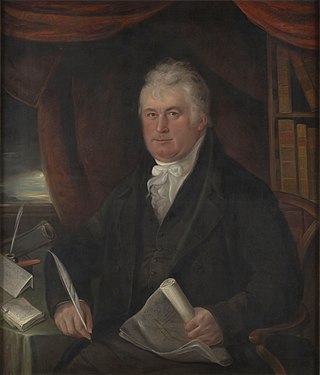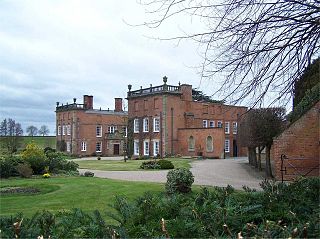
Earl of Leicester is a title that has been created seven times. The first title was granted during the 12th century in the Peerage of England. The current title is in the Peerage of the United Kingdom and was created in 1837.

Thomas William Coke, 1st Earl of Leicester, known as Coke of Norfolk or Coke of Holkham, was a British politician and agricultural reformer. Born to Wenman Coke, Member of Parliament (MP) for Derby, and his wife Elizabeth, Coke was educated at several schools, including Eton College, before undertaking a Grand Tour of Europe. He returned to Britain and married. When his father died he inherited a 30,000-acre Norfolk estate. Returned to Parliament in 1776 for Norfolk, Coke became a close friend of Charles James Fox, and joined his Eton schoolmate William Windham in his support of the American colonists during the American Revolutionary War. As a supporter of Fox, Coke was one of the MPs who lost their seats in the 1784 general election, and he returned to Norfolk to work on farming, hunting, and the maintenance and expansion of Holkham Hall, his ancestral home.
Holkham is a small village and civil parish in north Norfolk, England, which includes a stately home and estate, Holkham Hall, and a beach, Holkham Gap, at the centre of Holkham National Nature Reserve.

Thomas Coke, 1st Earl of Leicester, KB was an English land-owner and patron of the arts. He is particularly noted for commissioning the design and construction of Holkham Hall in north Norfolk. Between 1722 and 1728, he was one of the two Members of Parliament for Norfolk. He was honoured by being created first Earl of Leicester, in a recreation of an ancient earldom.

Matthew Brettingham, sometimes called Matthew Brettingham the Elder, was an 18th-century Englishman who rose from humble origins to supervise the construction of Holkham Hall, and become one of the country's best-known architects of his generation. Much of his principal work has since been demolished, particularly his work in London, where he revolutionised the design of the grand townhouse. As a result, he is often overlooked today, remembered principally for his Palladian remodelling of numerous country houses, many of them situated in the East Anglia area of Britain. As Brettingham neared the pinnacle of his career, Palladianism began to fall out of fashion and neoclassicism was introduced, championed by the young Robert Adam.

Holkham Hall is an 18th-century country house near the village of Holkham, Norfolk, England, constructed in the Neo-Palladian style for the 1st Earl of Leicester by the architect William Kent, aided by Lord Burlington.

Edward Douglas Coke, 7th Earl of Leicester,, styled Viscount Coke between 1976 and 1994, was an English nobleman. The Earl of Leicester was one of Norfolk's leading figures and played a key role in preserving and modernising the Holkham Estate over the last 40 years.

The Corn Exchange is an events and concert venue located on St Paul's Square in the Castle area of Bedford, Bedfordshire, England. The structure, which was commissioned as a corn exchange, is a Grade II listed building.

Leicester Corn Exchange is a commercial building in the Market Place in Leicester, Leicestershire, England. The structure, which currently operates as a public house, is a grade II* listed building.

Longford Hall is a 16th-century country house at Longford in the Dales district of Derbyshire, England. It is a Grade II* listed building.

The Edinburgh Corn Exchange is an events and concert venue located in New Market Road in Edinburgh, Scotland. The structure, which was commissioned as a corn exchange, is a Category B listed building.
The West Norfolk Junction Railway was a standard gauge eighteen and a half-mile single-track railway running between Wells-next-the-Sea railway station and Heacham in the English county of Norfolk. It opened in 1866 and closed in 1953. At Wells the line made a junction with the Wells and Fakenham Railway and at Heacham it connected with the line from Hunstanton to Kings Lynn.

The Corn Exchange is a commercial building in Cornhill, Bridgwater, Somerset, England. The structure, which is now used as a shopping arcade, is a Grade I listed building.
Richard Noverre Bacon was an English newspaper editor, known as a writer on agriculture.

Corn exchanges are distinct buildings which were originally created as a venue for corn merchants to meet and arrange pricing with farmers for the sale of wheat, barley, and other corn crops. The word "corn" in British English denotes all cereal grains, such as wheat and barley. With the repeal of the Corn Laws in 1846, a large number of corn exchanges were built in England, particularly in the corn-growing areas of Eastern England.

The Albert Hall is a commercial building in the High Street, Colchester, Essex, England. The structure, which was commissioned as a corn exchange and is now used as a bank, is a Grade II listed building.

The Corn Exchange is a commercial building in Tuesday Market Place, King's Lynn, Norfolk, England. The structure, which was commissioned as a corn exchange and is now used as an events venue, is a Grade II listed building.

The Corn Exchange is a commercial building in The Pantiles, Royal Tunbridge Wells, Kent, England. The structure, which is currently used as an antiques and fine art market, is a Grade II listed building.

The Corn Exchange is a commercial building in the Market Place, Fakenham, Norfolk, England. The structure, which is currently used as a cinema, is a Grade II listed building.

The Corn Hall is a commercial building in the Market Place, Swaffham, Norfolk, England. The structure, which is used as offices and as a coffee house, is a Grade II listed building.


















